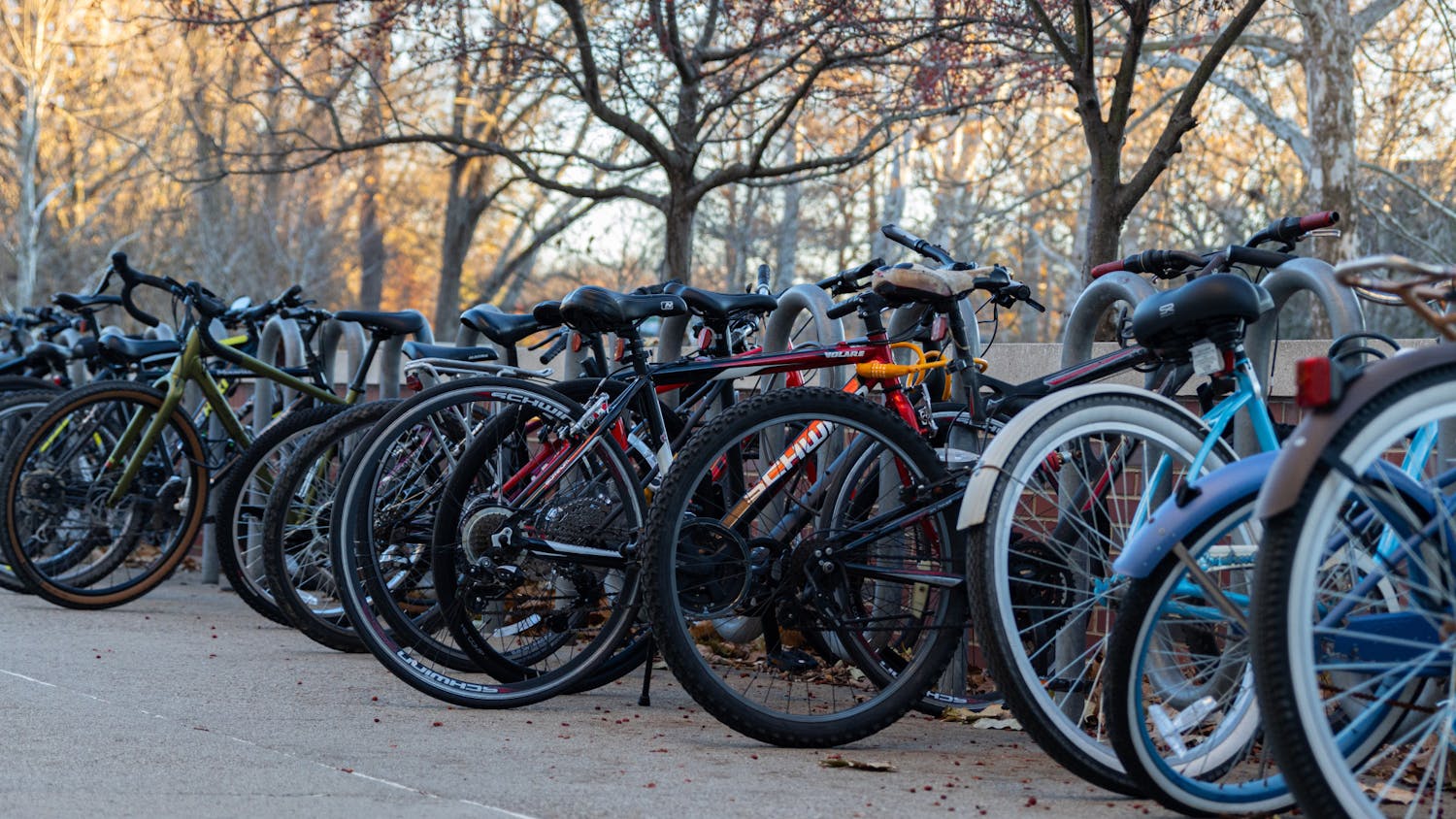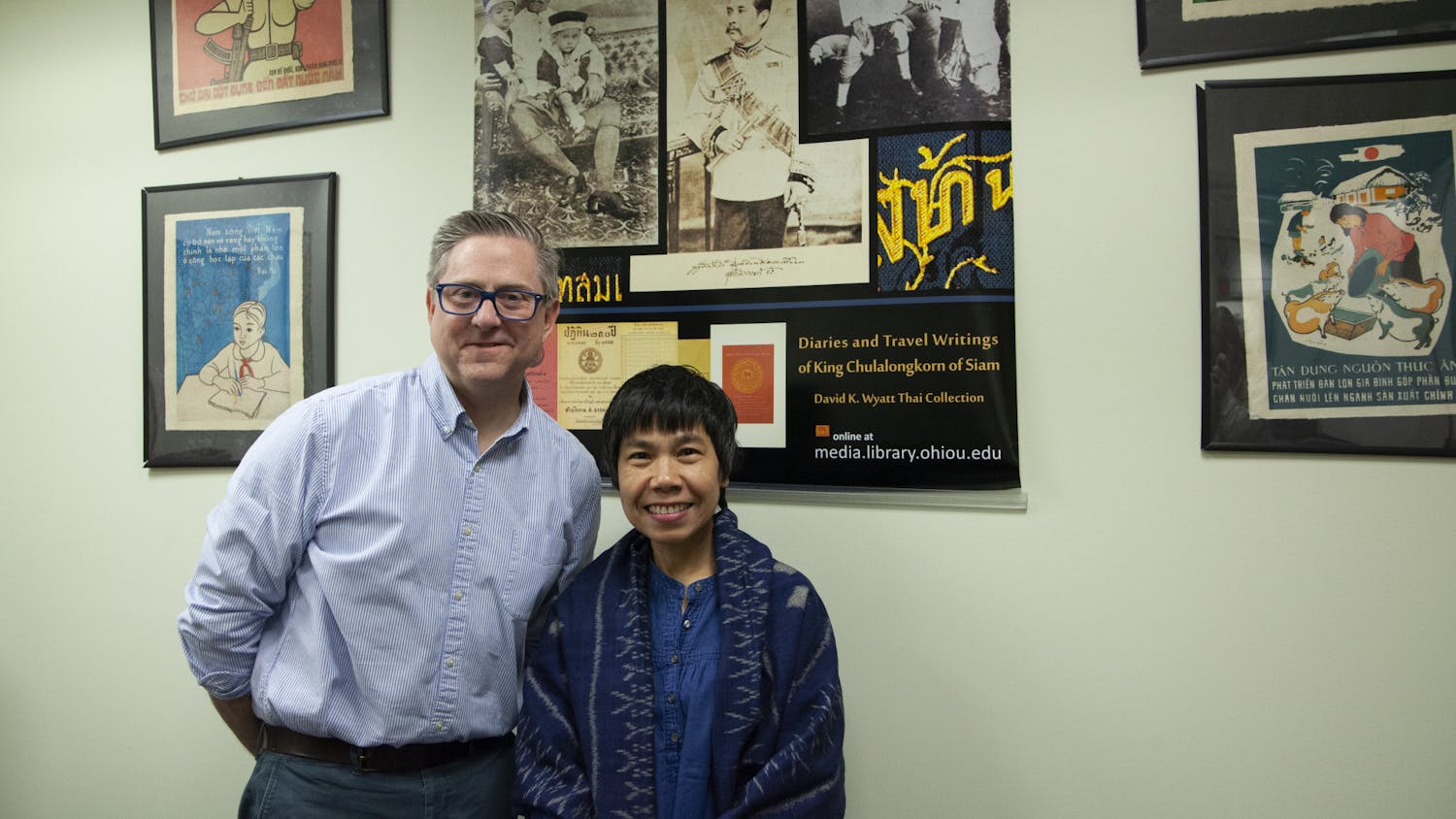While festgoers were swarming Mill Street, Dan Pirchner decided to take to the skies to film the action. But his feet never left the ground.
Piloting his DJI Phantom drone through a live feed on his phone at a field nearby, Pirchner quickly realized the connection between his phone and the drone had been lost. Instead, he had to control the drone by watching its movements from the ground.
“I think it’s awesome to get a different perspective of everything,” Pirchner said. “There’s people who take regular camera shots on the ground, but I think when you have a drone, you get this different picture, different videography angles of things in a whole new light. Everything looks a lot cooler from above.”
Drones, also known as unmanned aircraft systems, are vehicles operated by a pilot on the ground with remote control, or by a predetermined flight path. They can range in both size and use.
Pirchner, who lives in Georgia and was visiting his sister who attends Ohio University, said he learned to control a drone in about 25 minutes. He uses his drone to film footage for his YouTube channel, dpirch531, where he posted a video of Mill Fest and one of The Ridges.
As drone usage has increased in fields such as filmmaking, journalism and photography, the Federal Aviation Administration is stepping in to regulate the air.

More than a toy
Drones have been in existence long before the recent consumer craze — albeit, in more primitive forms. The growth of drones can be traced back to simple remote-controlled model planes, according to Michael Braasch, a professor of electrical engineering.
In fact, Nick Gigliotti, a freshman studying management information systems, said his interest in drones stemmed from his childhood when he played with remote-controlled toys.
“Ever since I was a little kid, I always loved flying,” Gigliotti said. “I kind of started researching into drones because it’s almost a safer way — it has a GPS in it. It knows where it’s at at all times. If you lose signal, it returns back to where it took off.”
Braasch, whose research primarily focuses on navigation and landing systems, first worked with drones at OU about 15 years ago with a group of students to create a drone with a camera and GPS for the class’ design project.
“Looking in retrospect, it’s a little funny because all of this stuff is available now,” Braasch said. “But at the time, it wasn’t.”
The mass production of gyroscopes, accelerometers and GPS systems for mobile phones have helped drones become widely accessible, Braasch said. A gyroscope detects any rotation or tilt of the phone, and accelerometers tell the phone when to switch to portrait or landscape view.
The gyroscopes and accelerometers inside modern drones keep them stable by sensing any imbalances. When the drone detects a tilt, the rotors automatically adjust to restabilize it. Because drones generally have four rotors, it is easier to keep them level. Vehicles such as helicopters have two rotors.
Modern multirotor drones don’t require the careful attention and training that remote-controlled planes do, Braasch said. Remote-controlled planes can’t hover like a helicopter and must maintain continuous motion in the air. Also, remote-controlled planes need a large amount of ground space to take off.
“It was like flying a real airplane — you had to learn how to fly the thing,” Braasch said. “And it took a lot of time to learn how to fly it safely.”

A new purpose
Aside from personal use, drones can be applicable to fields such as filmmaking and journalism.
“It’s a lot easier to buy one of these drones, take it up in the air and get the shot you want, rather than spending all the time to get the permit, to get the crane, setting up all that equipment,” Adam Schultz, the president of the new OU drone club, Aerial Robotics and Photography Association, said. “This is a thing that you can get into a location and within a couple of minutes be ready to shoot.”
Robert Stewart, the director of the E.W. Scripps School of Journalism, said he became interested in drones and how they can affect the news when he saw a video of protests in Thailand captured by a drone. He said aerial photography has existed for a while in the forms of helicopters and blimps, which are fairly expensive to use, and thus drones may have a niche in photojournalism.
“With a drone, which, relatively speaking is a much cheaper platform, you would be able to respond to news situations as they take place,” Stewart said. “Presumably that would add a new dimension to understanding events, if you can see them from that perspective.”
Freelance photojournalist Amos Chapple used drones to photograph locations like the Taj Mahal and the Moscow Kremlin that would have been otherwise impossible to take. Because he is unaware of what scene the camera is actually capturing, Chapple has had to overcome the obstacle of the less-involved process than traditional photography.
“The key thing is getting into a place where you can just fly up and fly straight back down again,” Chapple, who is from New Zealand, said. “If you have to turn it sideways, you never get things framed right.”

Regulating the air
On March 16 at the Schuneman Symposium for Photojournalism & New Media at OU, Chapple spoke about the “golden age” of drone photography, which he described as the period before any legislation was made to regulate drone usage.
Starting in December 2015, the Federal Aviation Administration began requiring all pilots who fly drones that weigh between 0.55 pounds and 55 pounds to register on the FAA website, which costs $5.
For any use other than for hobby, drone operators must be registered pilots.
Section 333 of the FAA Modernization and Reform Act of 2012 allows for certain operators to be exempt from the pilot requirement. For example, Stringer News Service from Long Island, New York, was granted an exemption for “aerial photography/videography for the television, print and online news industry,” according to the FAA. But because of heavy demand, that exemption may not be granted in a timely manner.
Drone pilots cannot surpass an altitude of 400 feet, must keep a visual line of sight with the drone, avoid stadiums and cannot fly within five miles of a major airport, according to the FAA.
If the codes are broken, punishments could come in the form of a warning, or, in more serious cases, civil penalties of up to $27,500 or criminal penalties of up to $250,000 and/or imprisonment of up to three years, according to the FAA.
Even in Ohio, the "birthplace of aviation,” three bills regarding drones have been introduced to the Ohio legislature. Two in the House, 218 and 228, discusses airports and drone usage, as well as documentation of drone purchase and crimes involving drones. One in the Senate, 251, would allow police to use drones to collect evidence.
The actual process of flying drones in public isn’t as simple as just pulling it out of the box and letting it go. The lack of a pilot physically in the air makes for a particular problem. Pilots are required to maintain a clear and active line of sight, but drones do not allow for peripheral vision because they are limited to what the camera sees, Braasch said.
Even when drones have a flight path pre-mapped through GPS, pilots can run into the problem of losing contact with their drone. Normally when an airplane pilot loses contact with the radio control tower, there is a standard FAA procedure to follow. But to engineer a drone that could act with the same level of reliability is almost impossible, Braasch said.
“It’s this trade off,” he said. “Things that worked fine given the fact that the pilot was there to take action in case of emergency — those same systems aren’t good enough when the pilot isn’t in the airplane anymore.”
Stewart said current regulations only allow journalists to use drones under “extremely limited circumstances,” in the United States.
“My thinking was, at some point that’s going to change because of this incredibly powerful news gathering tool,” he said.
Before you buy
Not all drones are alike, and some come with more features than others.
The Aerial Robotics and Photography Association owns a DJI Phantom, a drone with 28 minutes maximum flight time, a maximum speed of 44 mph and an onboard camera with 4k resolution.
Russell Gilabert, the vice president of the Aerial Robotics and Photography Association, recommended that a new user try a simple drone, such as the Cheerson CX-10, which costs about $15.
“The controls are the exact same as the controls for the professional, $500 controllers,” the first year graduate student studying electrical engineering said. “If you can learn how to fly something like that pretty well, (expensive drones) are cake.”
@seanthomaswolfe
sw399914@ohio.edu







